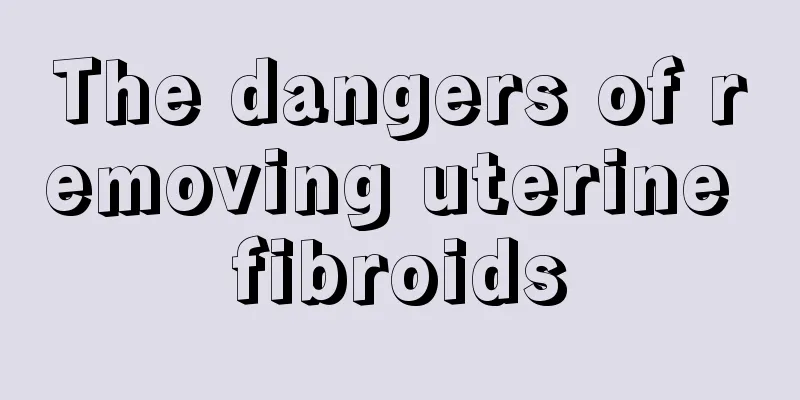How painful is it to give birth to a giant 8-pound baby?

|
Many mothers will know their baby's weight through examination during pregnancy. If the baby is huge, weighing about 8 kilograms, delivery will be extremely painful and may cause urethral incontinence. Mothers with more serious conditions will have to undergo detailed surgical treatment after delivery to avoid incontinence or severe tearing of the vagina. Although the anatomical and physiological characteristics of the vagina are conducive to the smooth delivery of the fetus, in fact, when the fetal head with a diameter of about 10 cm is delivered, if there is no help from the midwife to protect the perineum, then many mothers will definitely suffer varying degrees of perineum tears. Once a laceration occurs, it will leave sequelae of varying degrees after delivery. For example, some women suffer from uterine prolapse due to severe damage to the vagina and perineum, and even laceration of the anal sphincter and rectum, causing fecal incontinence and great pain. If episiotomy can be performed in time, the above-mentioned sequelae will not occur, and it will be beneficial to both the mother and the fetus. Clinically, women in the following situations need to undergo episiotomy. 1. If the perineum has poor elasticity, narrow vaginal opening, or there is inflammation or edema in the perineum, it is estimated that severe perineal tearing is inevitable when the fetus is delivered. 2. The fetus is large, the fetal head is in an incorrect position, and the labor force is weak, so the fetal head is blocked by the perineum. 3. For older mothers over 35 years old, or those with high-risk pregnancies such as heart disease, pregnancy-induced hypertension syndrome, etc., in order to reduce the physical exertion of the mother, shorten the labor process, and reduce the threat of delivery to the mother and baby, an episiotomy should be performed when the fetal head descends to the perineum. 4. The cervix is fully dilated and the fetal head is low, but the fetus has obvious hypoxia, the fetal heart rate changes abnormally, or the heartbeat rhythm is uneven, and the amniotic fluid is turbid or mixed with meconium. 5. When using forceps to assist delivery. Everything is divided into two. The perineum is close to the vagina in front and the anus in the back, and is home to many bacteria. Therefore, episiotomy is not a sterile procedure. Moreover, there are many bacteria living in the vagina. If the membranes rupture prematurely, labor is prolonged, and there is inflammation and edema in the vagina and perineum, the perineal incision may not heal well. In addition, postpartum bowel movements and lochia discharge may also cause the incision to become contaminated and become inflamed. Therefore, after perineal incision, the local area must be kept clean and hygienic, and it must be washed immediately with clean water after each urination or defecation to avoid contaminating the wound. |
<<: Ectopic pregnancy drug kills embryo and then discharges
>>: What is the best time for medical abortion?
Recommend
Picture of bleeding in urine during early pregnancy
Pregnancy is a very lucky thing for women. In the...
What is the hcg value when you are pregnant?
How much is the hcg value in early pregnancy? Gen...
[Medical Q&A] How long does it take for sunscreen to become invalid after it is opened?
Planner: Chinese Medical Association Reviewer: Ya...
What to do if you have stomach pain after uterine curettage
Uterine curettage is a surgery that needs to be p...
Should I steam eggs with cold water or boiling water? How can I steam eggs without them smelling fishy?
Steamed eggs are salty and fresh, rich in nutriti...
When is the best time to monitor ovulation with B-ultrasound?
For friends who want to use B-ultrasound to monit...
Poor ovarian reserve function, caused by these six reasons
Ovarian reserve function refers to the quality an...
Is there any harm in hymen repair?
The hymen has always represented a symbol of a wo...
Chinese people are not suitable for drinking milk? 85% of Chinese people are lactose intolerant? You have misunderstood for too many years!
Rumor: "Chinese people are not suitable for ...
When will Taobao's Happy Year Fruit Planting event end? How to play Taobao's Happy Year Fruit Planting event
Before the Chinese New Year, various shopping pla...
What to do if you sweat while sleeping after giving birth
We all know that women's bodies will become p...
How to regulate women's qi and blood deficiency
Female friends often encounter the situation of i...
In which month of the year are katydids common? What do katydids look like?
As an insect for appreciation and entertainment, ...
What are the symptoms of honeymoon vaginitis?
Vaginitis is the most common gynecological inflam...









